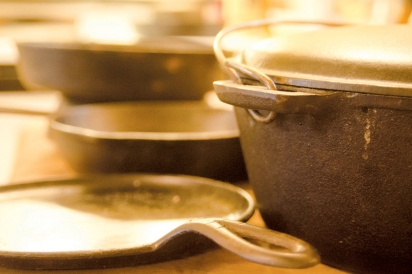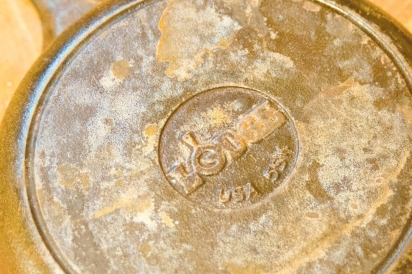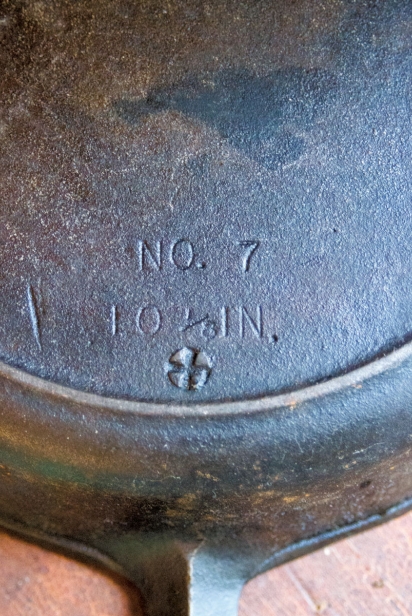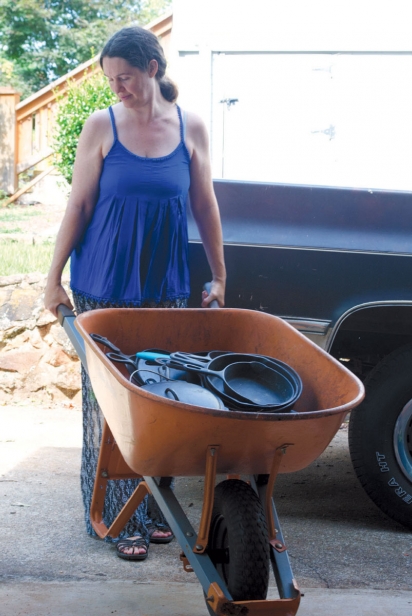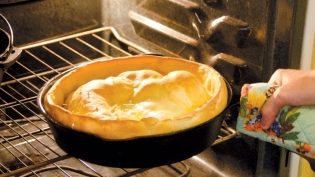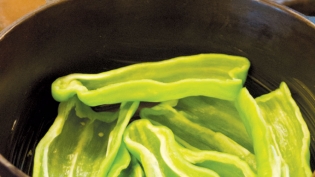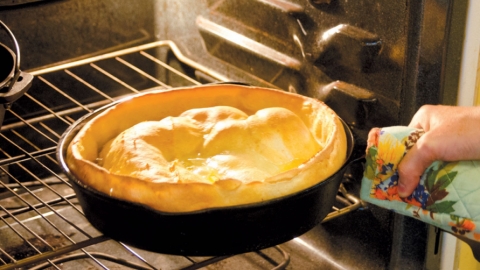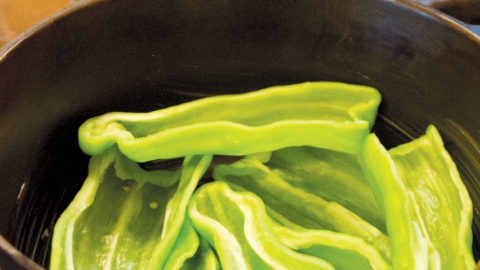They Don't Make It Like They Used To
How to Find and Identify Antique Boutique Cookware
After the gardening season winds down in autumn, my husband and I go antiquing nearly every weekend until spring. Telling people this elicits responses like, “Wow, expensive taste,” because (I assume) they’re imagining we buy 17th century inlaid mahogany armoires or George Vanderbilt’s diamond encrusted chamber pot. In reality, we’re infatuated with low-brow treasure hunts for stoneware crocks and unmarked cast iron cookware.
Once I mention cast iron, I’m told eager stories about how new pans don’t hold a candle to Grandma’s magnificent old heirloom skillet. The south is rich with aged, superior cast iron equal in craftsmanship to the most expensive pan made today, yet priced for less than a movie ticket at flea markets and antique malls. Great old pans are left to rust in attics and crumbling barns because modern consumers rarely know how to select and care for it.
Some of this stems from how cast iron cookware is manufactured today. Lodge is the only American brand of cast iron still operating since the late 1800s, but cookware aficionados prefer their older models. New Lodge Logic pans are based on design changes invented around the 1970s in order to appeal to consumers charmed by the convenience of Teflon; modern cooks didn’t want the extra step of seasoning a cast iron pan after purchasing it.
Lodge’s newer pans are cast with a deliberately pebbly, sandpaper-like texture that adheres to misted oil (then they’re blasted with heat on a factory conveyer, thus creating “pre-seasoned” pans). The smooth surface of the old models wouldn’t stick to the oil mist long enough to make it through the heating process, and the foresight of this design is why Lodge is still around today; Teflon’s success put the other cast iron brands out of business.
As an aside, “seasoning” is not, as someone once told me, “the accumulated gunk that adds the right flavor to food.” Eww! Seasoning is just a thin layer of fat heated until polymerization occurs which bonds to the metal as an inert, nonstick surface. Unlike Teflon, it’s nearly impossible to scratch with scrubby or a metal spatula (a popular myth). Once polymerization happens, you can’t even wash the seasoning off with dish detergent since it is no longer oil (yep, that’s mythical, too). If your “seasoning” comes off in your food when you cook or scrub, it’s not seasoning.
Vintage cast iron has a glassy cooking surface even before seasoning is added. Supposed “pre-seasoned” pans still need three or more layers of additional seasoning before they will truly perform as nonstick (seriously, have you ever tried to fry an egg in a brand new “pre-seasoned” pan because you’ll need a sandblaster for the cleanup).
When I do meet someone “in the know” about antique cast iron, they’ve heard the “Griswold” or “Wagner” labels are the best. The truth is that they’re just the most familiar and thus collectible. All of the American cast iron cookware brands made prior to the mid-1960s are equals in craftsmanship and performance. Don’t get me wrong, if I ever find a rare “spider logo” Griswold (worth several thousand dollars) at the bottom of a rusty heap I’ll be over the moon, but I know it won’t cook a caramelized upside down cake any better than my Granddad’s 1930’s unmarked Lodge that his parents probably picked up at the downtown Greenville Woolworths. For on-a-budget foodies looking to stock a kitchen with the very best cookware available, unmarked antique cast iron is the answer. That said, a massive quantity of the beat up, unmarked pans found in junk shops or flea markets for ten bucks often are Griswolds and Wagners manufactured without the logo (for sales in less fancy department stores without damaging their elite reputation).
The main variation in old cast iron cookware is pan thickness, which influences how you use them in the kitchen. Contrary to conventional wisdom, cast iron does not heat evenly and produces hot spots. The benefit of cast iron is that once heated, it stays hot and radiates heat further above the cooking surface. This is ideal when you want the interior of a dish to cook and not just the outer edges. The thicker the pan, the longer the heat will be maintained (if your burner is heating unevenly, place the skillet in the oven first). We use our thinnest cast iron for dishes that require a slight flick of the wrist and our thickest ones for onepot meals or baking.
If you’re like me, you’ll soon geek out on the different iron foundries and the methods and marks they used to produce their lines of pans. Pans created prior to the year 1890 can be quickly identified by a “gate mark” that looks like an appendectomy scar, usually on the bottom of the pan. This is because cast iron is literally named for being cast of molten metal injected into a fine sand mold with the resulting piece broken off from the injection site after it cools. After 1890, foundries had switched to a side-gate pour before grinding down the scar to make it invisible. I find gated 1800s pieces on a regular basis, though they often have endured more damage than the early 1900s pans.
Cast iron foundries were associated with corresponding brands of cookstoves. Variable like clothing sizes, the numbers stamped on cast iron pans (5, 8, 14, etc.) meant that the pan would fit into the same number “eye” (burner) of an affiliated brand’s wood burning stove. Recipes requiring a 10-inch skillet actually might need a #9 or #11. Take a ruler along if you want to know the actual pan size, though most recipes work fine without an exact match. Other marks keep track of patterns, molds or individual molders who worked at the factory. In the mid 20th century, manufacturers began labeling pieces with more specific measurements, and after 1960 pans started to carry a “Made in USA” or other country of origin stamp.
Unmarked pans can also be identified by handle shapes, pour spouts, “heat rings” (pans prior to 1940 had small bands of metal on the bottom to help the pan fit into the eye of wood burning stoves, later phased out when gas and electric burners became popular), the pan thickness, and when they appeared in old store catalogs. As an example, unmarked Lodge pans with a smooth surface and a heat ring bearing a single notch opposite the handle were made in the 1930s. Birmingham Stove and Range pans always have a peaked ridge underneath the handle that does not flatten out when it meets the bowl of the pan. Even if a pan has no other mark, I can instantly tell a 1930s Lodge or a BSR pan by these indicators.
The serious collector can dive down a rabbit hole of marks, foundry font styles, unique brand abbreviations, coveted rare pieces, and even various matching lids. None of this is necessary when choosing a great “user” piece for your kitchen. To identify a great pan, simply check that the surface is smooth, unpainted (for folk art), and undamaged.
Damaged pans are easy to identify as long as the iron surface isn’t too caked with gunk or rust. The first thing I check for is warping from uneven high heat, which bows the bottom (this usually only happens to pans placed in a fire or left empty on a hot burner). Plastic debit, credit or librarytype cards are a perfect makeshift straightedge to check for warping—simply place the card edge against the center of the pan and make sure it lies flush. If you can see underneath the card edge, the pan is warped. You can also do the “spin test” by placing the pan on the floor and attempting to spin it like a top. If it spins easily or rocks back and forth, it’s warped.
Next, check for chips and cracks in the sides, bottom and handle. Hold the pan in front of a bright window to see if light shines through any hairline cracks. The thinner a pan is, the more common warping and cracks are. Be wary of heavily crusted pans that hide cracks, though a well-seasoned pan can be used if cracks are tiny and filled with seasoning. Cracks don’t always render a pan unusable, but it greatly reduces the collector’s value.
Finally, take a look at the finish of the pan. A little rust or old seasoning is no problem; both can be removed and the pan reseasoned like new. Make sure rust discoloration has an orange tint and not a dark, dull, wine red hue which indicates heat damage (seasoning won’t stick well to the latter). If an unmarked pan passes all these tests and is less than $20.00 (Dutch oven with lids cost more), take it home!
Look up cleaning old cast iron pans with oven cleaner, lye baths or electrolysis. Seasoning is simple; just coat with a paper thin layer of high heat fat (lard, coconut oil, etc.) and bake the pan bottom-side-up at 450° for an hour; repeat at least three times. Touch up with additional seasoning layers after boiling water or cooking acidic foods, and never leave your pan to soak. If this sounds daunting, check out The Pan Handler, LLC to purchase vintage pans online that are already restored and reseasoned. Once you cook in it, you’ll need a cure for the crippling addiction of “castironitis.”



